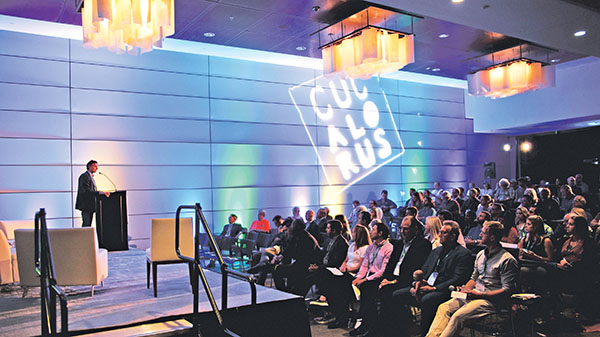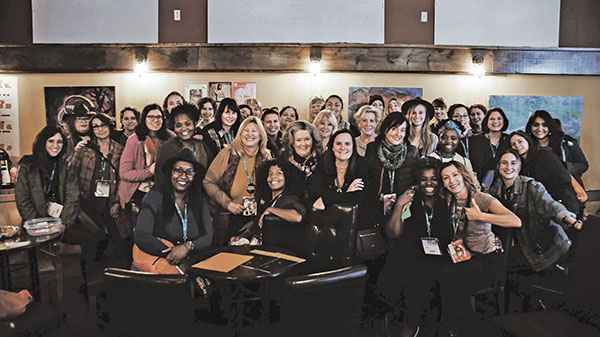In an era when few people sought out downtown Wilmington as a source of entertainment, a germinal one-night festival, held in a Water Street restaurant in 1994, drew an overflow crowd to its screening of 16 short films.
This year, Cucalorus celebrates its 25th anniversary. It has blossomed from what the filmmaker-founders termed “An Evening of Celluloid Art, a film festival for open minds” into a self-described “international celebration of filmmaking, performance and technology.”
The Evening of Celluloid Art was deliberately non-competitive, and the festival has remained so. In its 12th year, the festival moved from the spring of the year to early November, and Thalian Hall became its primary venue.
Compare Cucalorus’ start with its current size and scope: Last year, the festival showed 185 films, staged dance, comedy and music events, and hosted the fourth iteration of Cucalorus Connect, a business innovation and technology conference.

Those events took place in 31 venues around town. Gross revenues totaled about $475,000.
Cucalorus Connect, launched in 2015, was a spinoff of sorts from Coastal Connect, a conference hosted in 2014 by University of North Carolina Wilmington’s Center for Innovation and Entrepreneurship.
In its first year, Cucalorus Connect lasted five days and focused primarily on startup ventures. It debuted a Rocket Pitch session in which owners of young ventures gave a short spiel on their concept. It also introduced 10x10, in which 10 filmmakers were each paired with a startup. Each filmmaker entrepreneur team was given a very short time in which to create a promotional video for the company.
The 10x10 feature and Rocket Pitch remain in the roster this year to underscore Cucalorus’ continued support of startup ventures. Beyond that, the conference focus is becoming wider or more narrow, depending on one’s perspective.

“We have a much better idea of what we’re doing,” said Dan Brawley, the festival’s head, explaining that Cucalorus Connect’s mission is honing in on issues of justice and humanity in a world of technology and entrepreneurial endeavor.
You could also say, as Diane Durance does, that this mission widens the lens.
Cucalorus Connect wants to look at innovation and technology in fields that relate to quality of life in the local community, said Durance, director of UNCW’s CIE, which remains an essential partner in the business conference.
“Interest has grown in having an influential, impactful conference in Wilmington. We’re looking at bigger concepts: What is the future of … ?” Durance said, trailing off. “We’re thinking about energy and advanced manufacturing that may be in our future and areas where the university is strong. CastleBranch and tekMountain have been involved from the beginning.”
Growth is always on the minds of Cucalorus staffers. A perpetual item on Brawley’s desk is a list of 15 ways in which an organization can grow. The list is wrinkled and scribbled on, and he consults it often.

“Every year we look to expand five of these 15 numbers,” said Brawley, who leads the festival team and calls himself Cucalorus’ chief instigating officer.
“We think Cucalorus is accessible to many people, and we want to continue to grow. In five years I would like to see Cucalorus have an endowment, giving us more support to weather storms. We’ve had 7-9% annual growth in attendance, number of programs and revenue,” he said. “But if you try to push all (15 aspects) or grow too fast, you lose your values.”
And what are the festival’s values?
One is equity, as Cucalorus strives to have half of the films it screens be works directed by women and to provide opportunities to filmmakers of color. Brawley says that the commitment to equity that distinguished the original Evening of Celluloid Art still drives all aspects of the festival, including the business conference.
“Our passion remains connected to those early days, and I’m very happy to say that Cucalorus still champions unknown artists and focuses our resources on supporting women, artists of color, gay and trans artists, and other visionary humans who come to Cucalorus to share their stories,” Brawley said in a recent email to the festival’s supporters.

Another value is horizontal leadership.
“This can be frustrating,” Brawley admitted. “In a community, especially one that is democratic and horizontal, your power is based on a matrix of relationships. It takes a little longer to get things done, but we are willing to wait longer; we’re happy with living through the struggle to get to a better place. We think (the Cucalorus leadership model) is one of the essential contributions we make.”
Brawley and his colleagues spend considerable time discussing how to stay true to Cucalorus’ values while continuing to expand and innovate. They even ponder the use of the word “innovation” as perhaps too stale or overused.
“The last five years have been challenging for Cucalorus,” he said. “As a result of our success, many of our core values have been challenged. Any time you feel your values are questioned, you need to do some self-reflection.”
That self-examination led Brawley and his team to the conclusion that Cucalorus is, at its base, about community, a sense of connection to other human beings. And that brings Brawley back to the word “innovation.”

“What our consultant in New York would say is the beautiful thing about innovation is that it takes a group of people implementing a series of technological advances simultaneously; a series of leaps in harmony,” he said.
That definition of innovation and Cucalorus’ focus on community is causing Cucalorus Connect to evolve from its original spotlight on startup businesses working with emerging filmmakers to an examination of issues that create and influence community.
Chris Hillier, New Hanover Regional Medical Center’s executive director of innovation, has become involved with Cucalorus’ envisioning process this year as well as planning for the business conference. Partly because of him and his health care specialization, Cucalorus Connect has also taken a path into that field.
Durance said there would be a focus on coastal issues related to health and wellness.
Financial technology and health care technology, two growing elements in the Wilmington business community, are also topics for Cucalorus Connect, Durance said.
She wants to add marine science to the mix, given UNCW’s new bachelor’s degree program in coastal engineering and new Ph.D. in marine biology.
“One of the leaders coming this year is an expert on coastal issues: careful coastal development, improving poverty,” Durance said. “It’s about what you can do to help communities preserve their resources and help people get out of poverty and be eco-friendly, preserving what tourists want to see.”
“Coastal resilience” might be a holistic way to describe many of the elements coming together in the realm of human and natural environments, Durance added. And resilience is still on the minds of Connect planners after the devastation of a major coastal visitor two months before the 2018 conference.
“Hurricane Florence was very disruptive,” Durance said about the September storm that caused widespread flooding and evacuations in the area. “For example, we had planned a breakfast event in connection with (National) Minority Enterprise Development Week, but many of our region’s minority business owners were preoccupied with storm recovery and couldn’t attend, especially those in rural areas.”

At five years, Cucalorus Connect “can still be anything,” Brawley said, adding that the business conference has “tweaked the inner mechanism of Cucalorus in positive ways.”
Mike Orr, a retired IBM technical staff member and manager, is this year’s Cucalorus Connect program manager. He agrees with Brawley that the event is continuing to evolve.
“It’s always going to be about technology, but there is more emphasis on how technology can affect social issues,” he said. “Last year we had a couple of talks on AI (artificial intelligence) by UNCW professors. “Although they are coming back again, this year our keynoter will talk about how humans connect. We are moving away from heavy technology (subjects) to more about how technology affects our daily lives.
“As program manager, I want Cucalorus Connect to be considered by conference attendees on a par with the film and performance events, contending for people’s attendance,” he continued. “Heavy technology conferences are available elsewhere. We need to be offering something that is not easily gotten elsewhere.”

Featuring startups will continue to be important, Orr said, adding there is a need to serve that audience and the collaboration with the CIE takes advantage of Durance’s expertise in the field of entrepreneurship.
Even the startup spotlight elements, in Orr’s view, relate to technology’s role in improving quality of life.
“If you look at the 10x10 and Rocket Pitch, most of that is around ‘How does my startup help or affect other people?’ Some come across as ‘This is how,’” he said.
Brawley and Durance noted that this year’s Cucalorus Connect will move out of its previous home at Cape Fear Community College’s Union Station facility and into the Brooklyn Arts Center on North Fourth Street. Brawley is excited about the ways in which venues can influence events that take place inside them and believes that holding the conference in the BAC will contribute to a breakout year for Cucalorus Connect.

“Space is spiritual energy,” he said. “I think the BAC is the right space to mix (the conference parts) together.”
Durance also said she looks forward to the BAC setting.
“Union Station has a more classroom, office feel,” she said. “The BAC has more creative-type spaces. Our sessions will take advantage of that space and be less business-y and more flowing.”
Looking ahead, Brawley says that Cucalorus will continue to explore how the festival should grow and what should be the essence of Connect.
“We need to be open to the unexpected things that happen,” he said about the business conference’s evolution. “We want to continue to do challenging work. Finding the right space, with regard to scale, architecture and history, is an important part of that. That environment contributes to our push to be innovative, organic and authentic.”





 “What our consultant in New York would say is the beautiful thing about innovation is that it takes a group of people implementing a series of technological advances simultaneously; a series of leaps in harmony,” he said.
“What our consultant in New York would say is the beautiful thing about innovation is that it takes a group of people implementing a series of technological advances simultaneously; a series of leaps in harmony,” he said.





